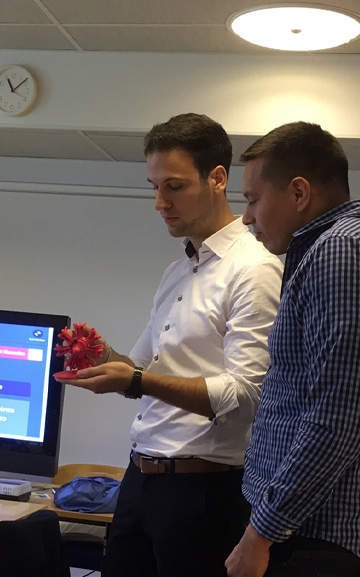
Additive Manufacturing and 3D Printing in Focus at EOS Workshop
Cencorp Automation organized a “3D printing is now” workshop in collaboration with EOS, the world leading 3D printing and additive manufacturing company.
The 2-day workshop was held in Cencorp headquarters in Salo on September 11-12, focusing on the possibilities of new revolutionary ways of manufacturing in the era of the 4th industrial revolution. The workshop was led by Business Consultant Christopher Schmitz from Additive Minds/EOS.
Please see the video below
The 3D workshop draw the attention of some 10 participants amongst Cencorp mechanical designers and engineers responsible for Cencorp innovative process automation solutions. Jorge Paredes, Mechatronic and Laser Processing Engineer at Cencorp Automation says ”I was really happy to get the phone call from EOS/Additive Minds that we had won the ”3D printing is now” workshop. This is a true value add for our team and opens up new visions in our product development.”
The feedback from the 2-day introduction to new and inspiring methods to make 3D printing on metal was very positive. The participants found the workshop useful and it offered to-the-point information and eye-opening use cases of 3D-printing in several industries.
The workshop was also documented and shared in social media by Bianca Heine, Social Media Manager at EOS.
EOS
EOS is the global technology and quality leader for high-end solutions in the field of additive manufacturing (AM). Founded in 1989, EOS is a pioneer and world leader in the field of Direct Metal Laser Sintering (DMLS) and provider of highly productive Additive Manufacturing Systems for plastic materials. EOS enables competitive advantages for a variety of industries, such as medical, aerospace, tooling, industry, lifestyle products and automotive.
Additive Manufacturing enables the fast, flexible and cost-efficient production of parts directly from 3D CAD data. AM refers to a process by which digital 3D design data is used to build up a component in layers by depositing material. Instead of milling a workpiece from solid block, for example, Additive Manufacturing builds up components layer by layer using materials which are available in fine powder form. A range of different metals, plastics and composite materials may be used.
The strengths of Additive Manufacturing lie in those areas where conventional manufacturing reaches its limitations. AM allows for highly complex structures which can still be extremely light and stable. It provides a high degree of design freedom, the optimisation and integration of functional features, the manufacture of small batch sizes at reasonable unit costs and a high degree of product customisation even in serial production.

